2011 PEUGEOT 5008 engine
[x] Cancel search: enginePage 144 of 340
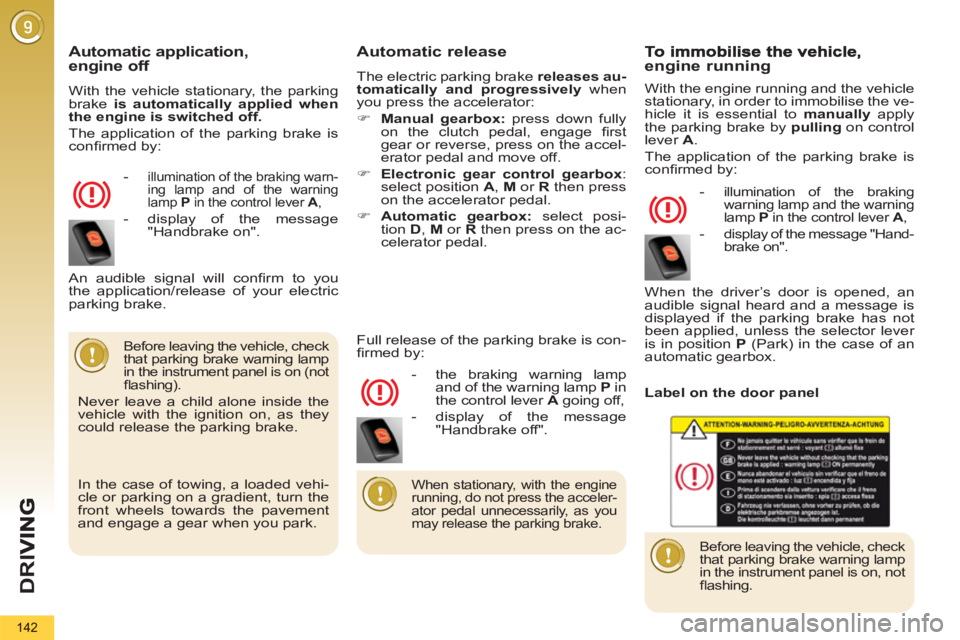
D
R
I
142
Automatic application,engine off
With the vehicle stationary, the parking
brake is automatically applied when
the engine is switched off.
The application of the parking brake is
confi rmed by:
-
illumination of the braking warn-
ing lamp and of the warning
lamp P
in the control lever A
,
- display of the message
"Handbrake on".
Automatic release
The electric parking brake releases au-
tomatically and progressively
when
you press the accelerator:
�)
Manual gearbox:
press down fully
on the clutch pedal, engage fi rst
gear or reverse, press on the accel-
erator pedal and move off.
�)
Electronic gear control gearbox
:
select position A
, M
or R
then press
on the accelerator pedal.
�)
Automatic gearbox:
select posi-
tion D
, M
or R
then press on the ac-
celerator pedal.
Before leaving the vehicle, check
that parking brake warning lamp
in the instrument panel is on (not
fl ashing).
Never leave a child alone inside the
vehicle with the ignition on, as they
could release the parking brake.
- the braking warning lamp
and of the warning lamp P
in
the control lever A
going off,
- display of the message
"Handbrake off". An audible signal will confi rm to you
the application/release of your electric
parking brake.
Full release of the parking brake is con-
fi rmed by:
engine running
With the engine running and the vehicle
stationary, in order to immobilise the ve-
hicle it is essential to manually
apply
the parking brake by pulling
on control
lever A
.
The application of the parking brake is
confi rmed by:
-
illumination of the braking
warning lamp and the warning
lamp P
in the control lever A
,
- display of the message "Hand-
brake on".
When the driver’s door is opened, an
audible signal heard and a message is
displayed if the parking brake has not
been applied, unless the selector lever
is in position P
(Park) in the case of an
automatic gearbox.
Before leaving the vehicle, check
that parking brake warning lamp
in the instrument panel is on, not
fl ashing.
When stationary, with the engine
running, do not press the acceler-
ator pedal unnecessarily, as you
may release the parking brake.
In the case of towing, a loaded vehi-
cle or parking on a gradient, turn the
front wheels towards the pavement
and engage a gear when you park.
Label on the door panel
Page 145 of 340
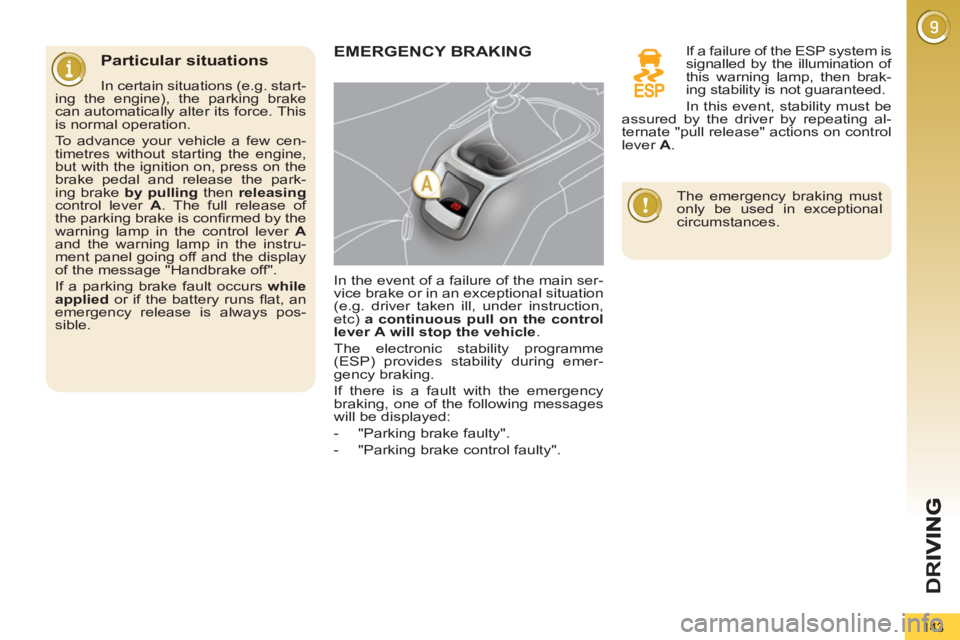
D
R
143
Particular situations
In certain situations (e.g. start-
ing the engine), the parking brake
can automatically alter its force. This
is normal operation.
To advance your vehicle a few cen-
timetres without starting the engine,
but with the ignition on, press on the
brake pedal and release the park-
ing brake by pulling
then releasing
control lever A
. The full release of
the parking brake is confi rmed by the
warning lamp in the control lever A
and the warning lamp in the instru-
ment panel going off and the display
of the message "Handbrake off".
If a parking brake fault occurs while
applied
or if the battery runs fl at, an
emergency release is always pos-
sible.
EMERGENCY BRAKING
In the event of a failure of the main ser-
vice brake or in an exceptional situation
(e.g. driver taken ill, under instruction,
etc) a continuous pull
on the control
lever
A
will stop the vehicle
.
The electronic stability programme
(ESP) provides stability during emer-
gency braking.
If there is a fault with the emergency
braking, one of the following messages
will be displayed:
- "Parking brake faulty".
- "Parking brake control faulty".
If a failure of the ESP system is
signalled by the illumination of
this warning lamp, then brak-
ing stability is not guaranteed.
In this event, stability must be
assured by the driver by repeating al-
ternate "pull release" actions on control
lever A
.
The emergency braking must
only be used in exceptional
circumstances.
Page 146 of 340
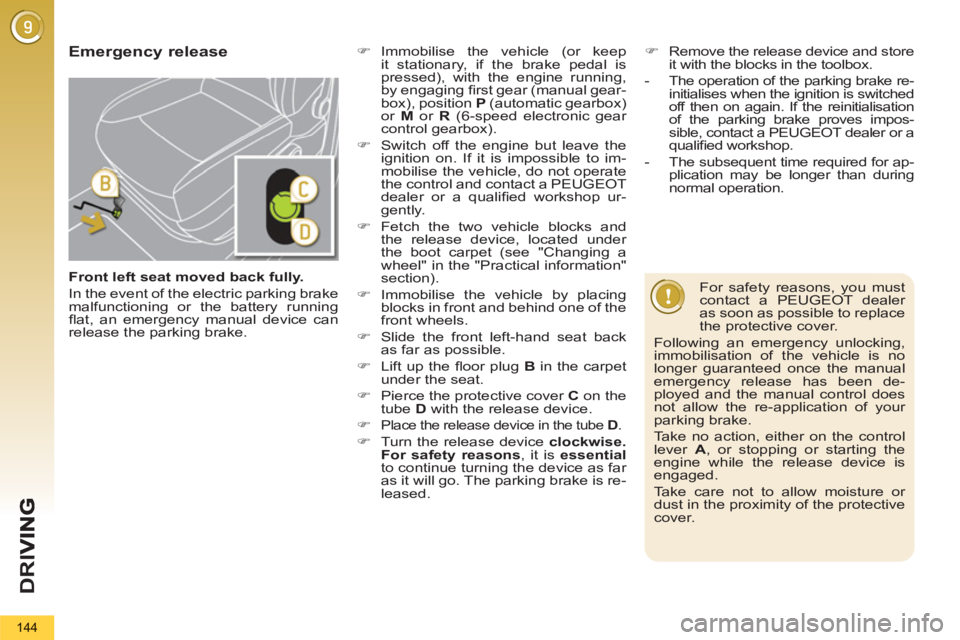
D
R
I
144
Front left seat moved back fully.
In the event of the electric parking brake
malfunctioning or the battery running
fl at, an emergency manual device can
release the parking brake.
Emergency release
�)
Immobilise the vehicle (or keep
it stationary, if the brake pedal is
pressed), with the engine running,
by engaging fi rst gear (manual gear-
box), position P
(automatic gearbox)
or M
or R
(6-speed electronic gear
control gearbox).
�)
Switch off the engine but leave the
ignition on. If it is impossible to im-
mobilise the vehicle, do not operate
the control and contact a PEUGEOT
dealer or a qualifi ed workshop ur-
gently.
�)
Fetch the two vehicle blocks and
the release device, located under
the boot carpet (see "Changing a
wheel" in the "Practical information"
section).
�)
Immobilise the vehicle by placing
blocks in front and behind one of the
front wheels.
�)
Slide the front left-hand seat back
as far as possible.
�)
Lift up the fl oor plug B
in the carpet
under the seat.
�)
Pierce the protective cover C
on the
tube D
with the release device.
�)
Place the release device in the tube D
.
�)
Turn the release device clockwise.
For safety reasons
, it is essential
to continue turning the device as far
as it will go. The parking brake is re-
leased.
�)
Remove the release device and store
it with the blocks in the toolbox.
- The operation of the parking brake re-
initialises when the ignition is switched
off then on again. If the reinitialisation
of the parking brake proves impos-
sible, contact a PEUGEOT dealer or a
qualifi ed workshop.
- The subsequent time required for ap-
plication may be longer than during
normal operation.
For safety reasons, you must
contact a PEUGEOT dealer
as soon as possible to replace
the protective cover.
Following an emergency unlocking,
immobilisation of the vehicle is no
longer guaranteed once the manual
emergency release has been de-
ployed and the manual control does
not allow the re-application of your
parking brake.
Take no action, either on the control
lever A
, or stopping or starting the
engine while the release device is
engaged.
Take care not to allow moisture or
dust in the proximity of the protective
cover.
Page 147 of 340
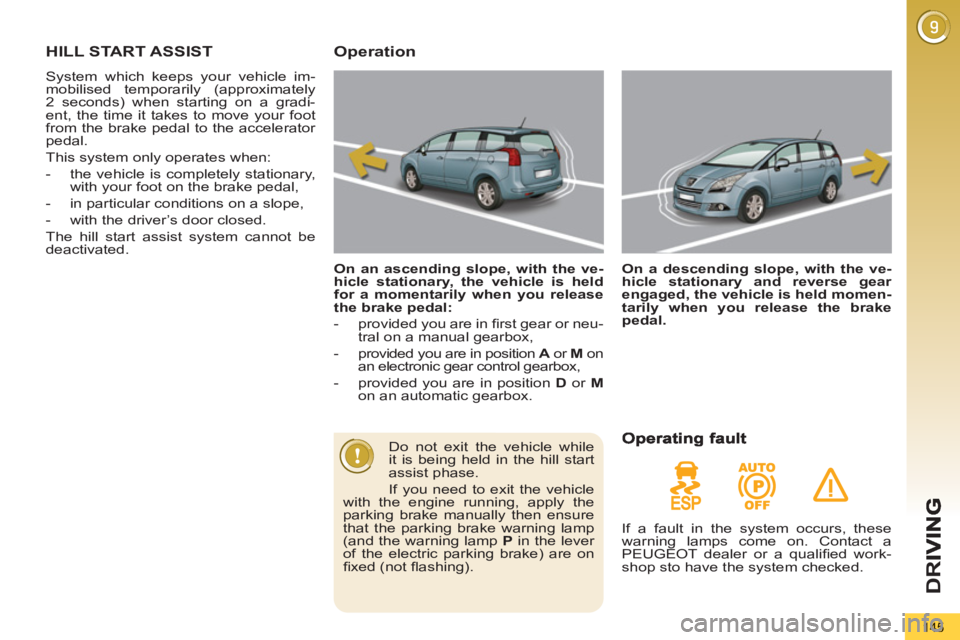
D
R
145
HILL START ASSIST
System which keeps your vehicle im-
mobilised temporarily (approximately
2 seconds) when starting on a gradi-
ent, the time it takes to move your foot
from the brake pedal to the accelerator
pedal.
This system only operates when:
- the vehicle is completely stationary,
with your foot on the brake pedal,
- in particular conditions on a slope,
- with the driver’s door closed.
The hill start assist system cannot be
deactivated.
Operation
On an ascending slope, with the ve-
hicle stationary, the vehicle is held
for a momentarily when you release
the brake pedal:
- provided you are in fi rst gear or neu-
tral on a manual gearbox,
- provided you are in position A
or M
on
an electronic gear control gearbox,
- provided you are in position D
or M
on an automatic gearbox.
On a descending slope, with the ve-
hicle stationary and reverse gear
engaged, the vehicle is held momen-
tarily when you release the brake
pedal.
Do not exit the vehicle while
it is being held in the hill start
assist phase.
If you need to exit the vehicle
with the engine running, apply the
parking brake manually then ensure
that the parking brake warning lamp
(and the warning lamp P
in the lever
of the electric parking brake) are on
fi xed (not fl ashing).
If a fault in the system occurs, these
warning lamps come on. Contact a
PEUGEOT dealer or a qualifi ed work-
shop sto have the system checked.
Page 149 of 340

D
R
147
Situations
Consequences
Display of the message " Parking
brake control fault - auto parking
brake activated
" and of the following
warning lamps:
- Only the automatic application on switching off the engine and automatic re-
lease on acceleration functions are available.
- The manual application/release of the electric parking brake and the emer-
gency braking are not available.
and possibly
fl ashing
Battery fault
- If the battery warning lamp comes on you must stop immediately as soon as
the traffi c allows. Stop and immobilise your vehicle (if necessary, place the two
chocks under the wheels).
- Apply the electric parking brake before switching off the engine.
Page 150 of 340
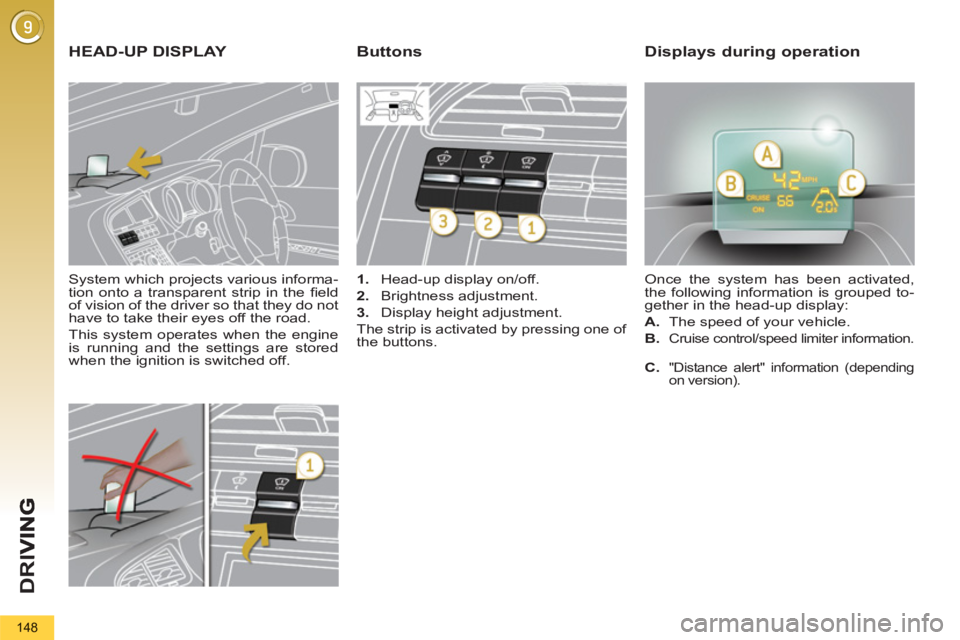
D
R
I
148
System which projects various informa-
tion onto a transparent strip in the fi eld
of vision of the driver so that they do not
have to take their eyes off the road.
This system operates when the engine
is running and the settings are stored
when the ignition is switched off.
HEAD-UP DISPLAY
1.
Head-up display on/off.
2.
Brightness adjustment.
3.
Display height adjustment.
The strip is activated by pressing one of
the buttons. Once the system has been activated,
the following information is grouped to-
gether in the head-up display:
A.
The speed of your vehicle.
B.
Cruise control/speed limiter information.
Buttons Displays during operation
C.
"Distance alert" information (depending
on version).
Page 151 of 340
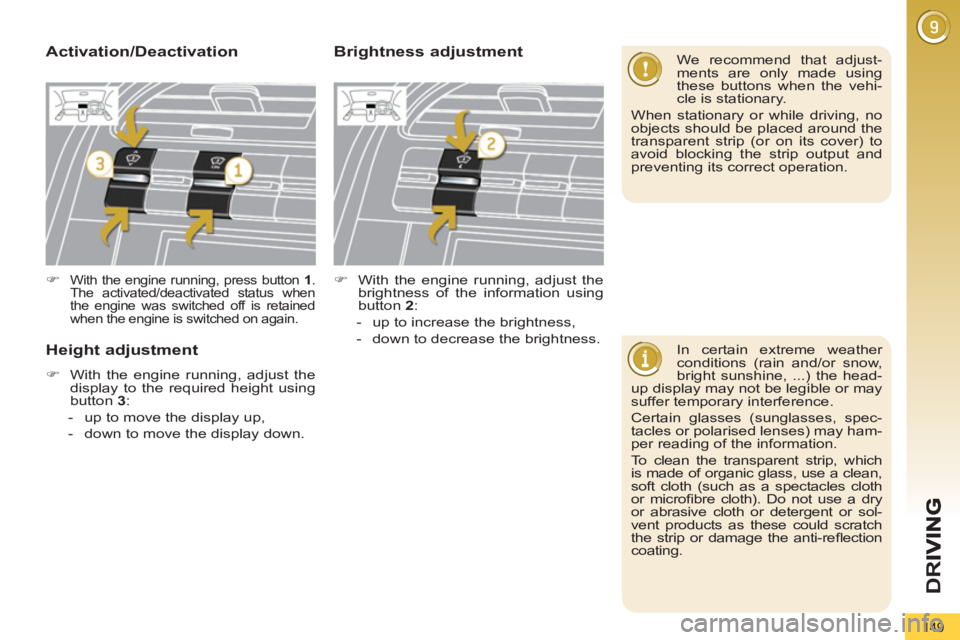
D
R
149
In certain extreme weather
conditions (rain and/or snow,
bright sunshine, ...) the head-
up display may not be legible or may
suffer temporary interference.
Certain glasses (sunglasses, spec-
tacles or polarised lenses) may ham-
per reading of the information.
To clean the transparent strip, which
is made of organic glass, use a clean,
soft cloth (such as a spectacles cloth
or microfi bre cloth). Do not use a dry
or abrasive cloth or detergent or sol-
vent products as these could scratch
the strip or damage the anti-refl ection
coating.
We recommend that adjust-
ments are only made using
these buttons when the vehi-
cle is stationary.
When stationary or while driving, no
objects should be placed around the
transparent strip (or on its cover) to
avoid blocking the strip output and
preventing its correct operation.
�)
With the engine running, press button 1
.
The activated/deactivated status when
the engine was switched off is retained
when the engine is switched on again.
Height adjustment
�)
With the engine running, adjust the
display to the required height using
button 3
:
- up to move the display up,
- down to move the display down.
Activation/Deactivation Brightness adjustment
�)
With the engine running, adjust the
brightness of the information using
button 2
:
- up to increase the brightness,
- down to decrease the brightness.
Page 158 of 340

D
R
I
156
6-SPEED MANUAL GEARBOX
As a safety precaution and to
facilitate starting of the engine:
Only engage reverse gear
when the vehicle is stationary
with the engine at idle.
Engaging 5th or 6th gear
�)
Move the lever fully to the right to
engage 5th or 6th gear.
*
According to engine.
GEAR EFFICIENCY INDICATOR *
System which reduces fuel consumption
by advising the driver to change up on
vehicles fi tted with a manual gearbox.
Operation
The system intervenes only when driv-
ing economically.
Depending on the driving situation and
your vehicle's equipment, the system
may advise you to skip one or more
gears. You can follow this instruc-
tion without engaging the intermediate
gears.
The gear recommended should not
be considered compulsory. In fact, the
confi guration of the road, the amount
of traffi c and safety remain determining
factors when choosing the best gear.
Therefore, the driver remains responsi-
ble for deciding whether or not to follow
the advice given by the system.
This function cannot be deactivated.
Example:
- You are in third gear.
In the case of driving which makes
particular demands on the perfor-
mance of the engine (fi rm pres-
sure on the accelerator pedal, for example,
when overtaking...), the system will not rec-
ommend a gear change.
The system never suggests:
- engaging fi rst gear,
- engaging reverse gear,
- engaging a lower gear.
- You press the accelerator pedal
moderately.
- The system may suggest that you
engage a higher gear, if appropriate.
The information appears in the form
of an arrow in the instrument panel
screen.
Depending on your vehicle's equipment,
this arrow may be accompanied by the
recommended gear.
This equipment will become available
during the year.
- always select neutral,
- press the clutch pedal.
�)
Raise the ring under the knob and
move the gear lever to the left then
forwards.
Engaging reverse gear